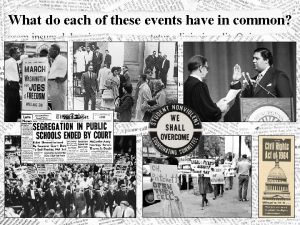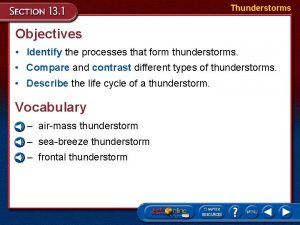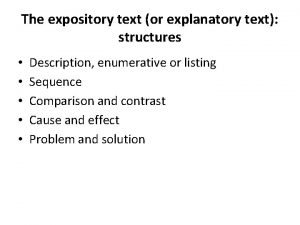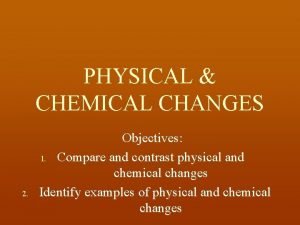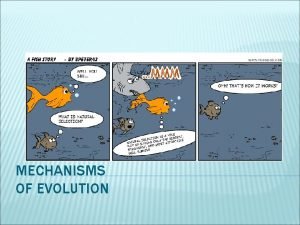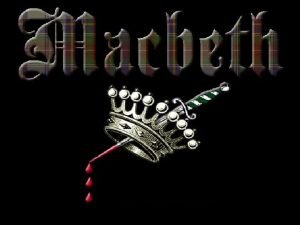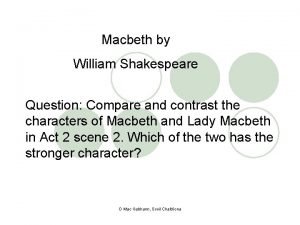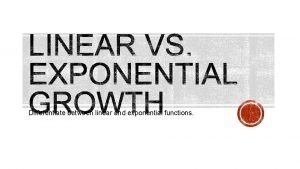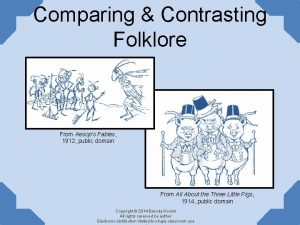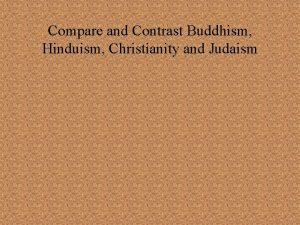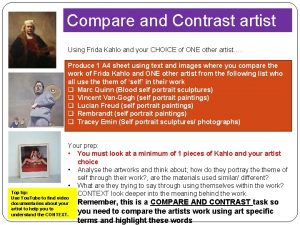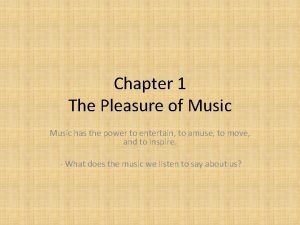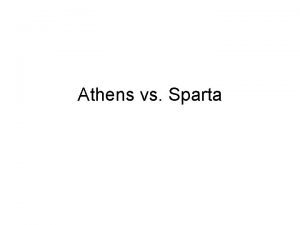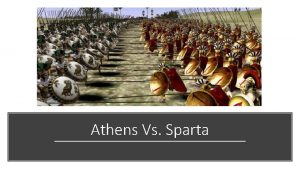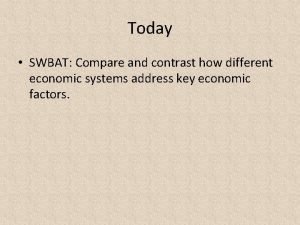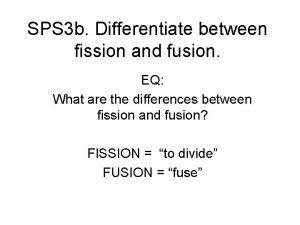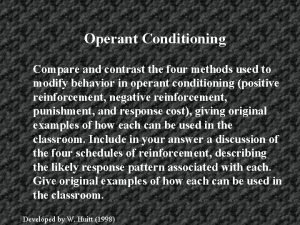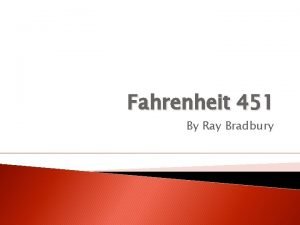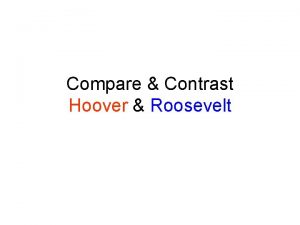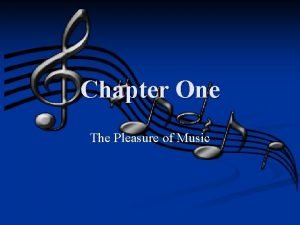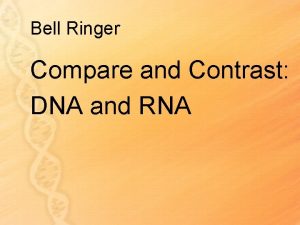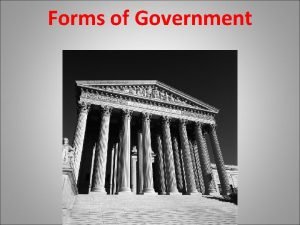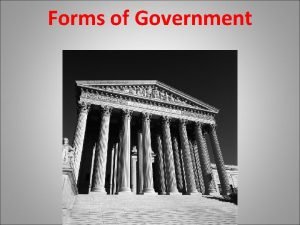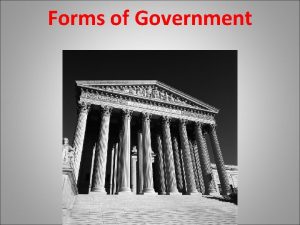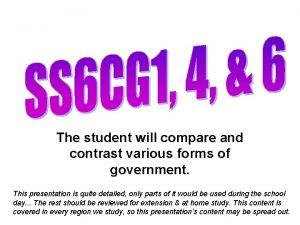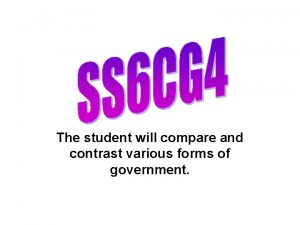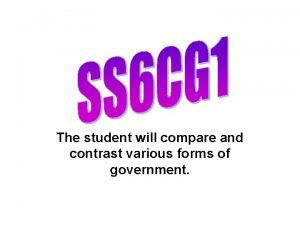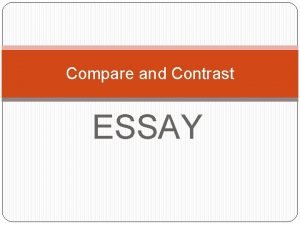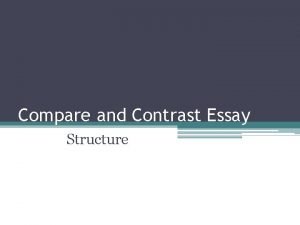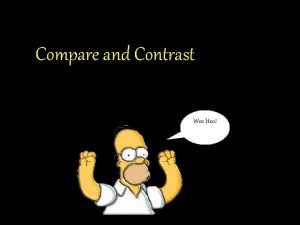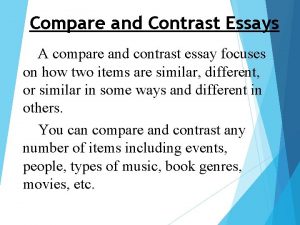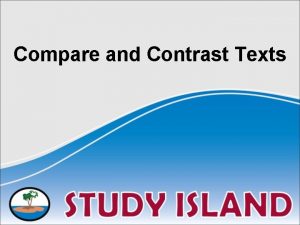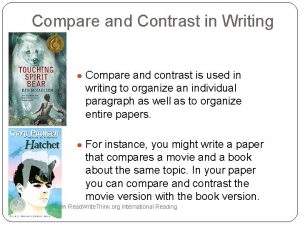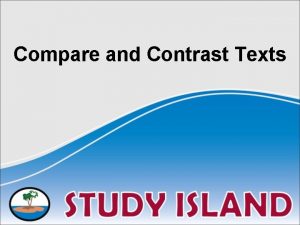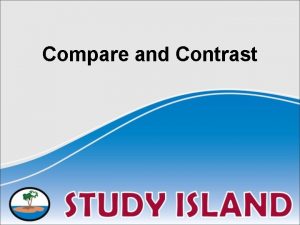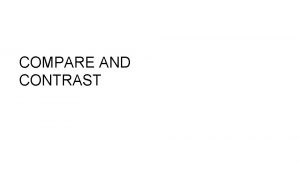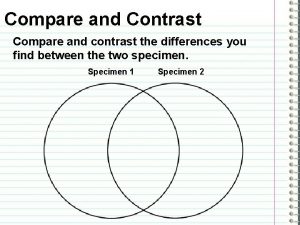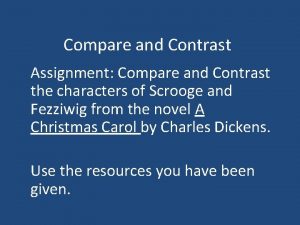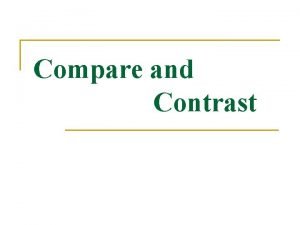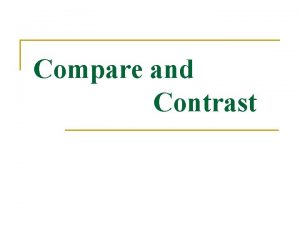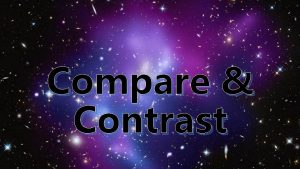The student will compare and contrast various forms














































- Slides: 46

The student will compare and contrast various forms of government.

ELEMENT A Describe the ways government systems distribute power: unitary, confederation, and federal.

What is Government? • - How society makes and enforces public policies. • The purpose of government – Order – Stability – Growth • Examples: – – – Taxation Defense Education Crime Health

Government comes in many different forms. • Unitary • Confederation • Federal

Unitary Ways Government Distributes Power is held by one central authority.

Unitary Governments (Cont. ) All the power to decide anything rests in a central government. Buckingham Palace, Great Britain A unitary government is what Britain was during the American Revolution; We were a nation united under control of one rule. There were no separate states creating their own laws or taxes, just the rule of the government over the entire population. A great majority of all the world’s nation-states are unitary systems, including, Bulgaria, France, Great Britain, The Netherlands, Japan, Poland, Romania, the Scandinavian countries, Spain, and many of the Latin-American and African countries.

Unitary Ways Government Distributes Power Regional Authority Central Authority Regional Authority

List of Unitary States Afghanistan Albania Abkhazia Algeria Angola Armenia Azerbaijan Bangladesh Belarus Belize Benin Bhutan Bolivia Botswana Brunei Bulgaria Burkina Faso Burundi Cambodia Cameroon Cape Verde Central African Republic Chad Chile People's Republic of China Colombia Congo (Brazzaville) Congo (Kinshasa) Costa Rica Côte d'Ivoire Croatia Cuba Cyprus Czech Republic Denmark Djibouti Dominican Republic East Timor Ecuador Egypt El Salvador Equatorial Guinea

List of Unitary States Eritrea Estonia Fiji Finland France Gabon The Gambia Georgia Ghana Greece Grenada Guatemala Guinea-Bissau Guyana Haiti Honduras Hungary Iceland Indonesia Iran Ireland Israel Italy Jamaica Japan Jordan Kazakhstan Kenya Kiribati Kuwait Kyrgyzstan Laos Latvia Lebanon Lesotho Liberia Libya Liechtenstein Lithuania Luxembourg Macedonia Madagascar Malawi Maldives

What are the advantages and disadvantages to a unitary system as a form of government? • Advantages: All decisive legislative and/or executive offices are held by a single, central government. Smaller government. • Disadvantages: Little in the way of power balances. Slow government response (for instance no state national guard that could be dispatched in an emergency, troops would have to be mobilized from national authority). Easily looses track of local issues.

Confederation Government Ways Government Distributes Power • In a confederation, the power to govern is held by an alliance of independent states. • It is a group of independent states that form a central government that is very limited in power. • In a confederation system, each state is ultimately given all powers to run their own state, and the central government is very weak.

Confederation Governments a union by compact or treaty between states, provinces, or territories, that creates a central government with limited powers; the states retain supreme authority over all matters except those few things delegated to the central government. Switzerland, Belgium and the original 13 U. S. Colonies formed a Confederation.

Confederation Ways Government Distributes Power Regional Authority Central Authority Regional Authority

List of Confederations- Today Iroquois Confederacy (1090–present) European Union and OPEC Historic confederations Some have more the characteristics of a personal union, but they are still listed here because of their own self-styling. Crown of Aragon (1137– 1716) Polish-Lithuanian Commonwealth (confederated personal union; 1447– 1492, 1501– 1569, (different governments, armies, treasuries, laws, territories with borders, citizenships; common monarch (Grand Duke of Lithuania and King of Poland), parliament (Sejm) and currency) Switzerland (1291– 1848), officially the Swiss Confederation Republic of the Seven United Provinces of the Netherlands (1581 -1795) Confederate Ireland (1641 -1649)

Historic confederations New England Confederation (1643– 1684) United States of America under the Articles of Confederation (1781– 1789) Confederate States of America, (1861– 1865) Aro Confederacy, (1690 -1902), in what is now Nigeria, Cameroon and Equatorial Guinea Union of African States (1961– 1963, Mali+Ghana+Guinea) Senegambia (1982– 1989, Senegal+Gambia) Hanseatic League United Provinces of New Granada (1810– 1816 in what is now Colombia) Powhatan Confederacy Carlist States in Spain (1872– 1876) Serbia and Montenegro (2003– 2006)

What are the advantages and disadvantages to a confederation system as a form of government? • Advantages: State rights would be guaranteed. Supreme Court could not legislate. Local government help citizens needs. • Disadvantages: Weak national government. Small military. Weak economy.

Federal (Federation) Ways Government Distributes Power is divided between one central and several regional authorities. Teacher Notes: Students should be able to describe the ways governments distribute power, or identify the type of distribution from a description.

Federal or (Federation) Ways Government Distributes Power Regional Authority Central Authority Regional Authority

What are the advantages and disadvantages to a federal system as a form of government? • Advantages: There are several checks and balances so the National government and the state governments. • Disadvantages: There may be infringements on other states, often causing rivalry and competition.

Sample Test Question In Nigeria’s government, power is divided between Central and regional authorities. This is an example of which government type? A. Unitary B. Confederation C. Federal D. Parliamentary Corresponds to SS 6 - CG 1 a, CG 4 a, CG 6 a SS 7 - CG 1 a , CG 4 a, CG 6 a

Sample Test Question In Nigeria’s government, power is divided between Central and regional authorities. This is an example of which government type? A. Unitary B. Confederation C. Federal* D. Parliamentary Corresponds to SS 6 - CG 1 a, CG 4 a, CG 6 a SS 7 - CG 1 a , CG 4 a, CG 6 a

Review Unitary Power rests in a single central government Confederation Alliance among Independent states/regions to create a limited central government Central government has No control over the States/regions. Federal Power is shared Between the central Government and the States/regions Central government has Some control over the States/regions.

Element B Explain how governments determine citizen participation: autocratic, oligarchic, and democratic.

Autocratic Governments In an autocratic government, one person or group holds all the power, without the participation, or sometimes even the consent, of the people. I have complete control over everyone and everything! The word “autocracy, ” the opposite of democracy, comes from the Greek words: “autos” meaning “self” and “kratos” meaning “power. ” Absolute Monarchy You will do exactly what I say! Military Dictatorship

Autocracy • Government by a single person having unlimited power; despotism (domination through threat of punishment and violence).

What countries have an autocratic government? • • Cuba Morocco Behrain Oman Jordan Quatar Kuwait

Oligarchic Governments a government in which control is exercised by a small group of individuals whose authority generally is based on wealth or power. The word oligarchy is from the Greek for "few" and "rule".

Oligarchy • A government in which a few people such as a dominant clan or clique have power.

What countries have an Oligarchic government? • • China North Korea Saudi Arabia Russia

Democratic Governments a form of government in which the supreme power is retained by the people, but which is usually exercised indirectly through a system of representation and delegated authority periodically renewed. When citizens directly participate in government by voting, it’s called democracy. The word “democracy” comes from two Greek words: “demos” meaning “people” and “kratos” meaning “power” or “authority. ” The United States had the same type of government for more than 200 years. It’s called a “representative democracy. ” Among the nations of the world, it is unusual for a system of government to last so long.

Democratic Government(Cont. ) • In a democracy, the government is elected by the people. Everyone who is eligible to vote has a chance to have their say over who runs the country. It is distinct from governments controlled by a particular social class or group (aristocracy; oligarchy) or by a single person (despotism; dictatorship; monarchy). • A democracy is determined either directly or through elected representatives.

What countries have an democratic government? • • • USA Italy Iceland Norway Greece Denmark

Review Autocracy Oligarchy Democracy One person has all the power A small group of people have all the authority, usually based on wealth or power. The people elect representatives who have authority to make decisions for them. Only a few people have a right to say what the government does All people have a right to say what the government does The people have no right to say what the government does

Element C Describe the two predominate forms of democratic governments: parliamentary and presidential.

Parliamentary Governments a political system in which the legislature (parliament) selects the government - a prime minister, premier, or chancellor along with the cabinet ministers - according to party strength as expressed in elections; by this system, the government acquires a dual responsibility: to the people as well as to the parliament. The majority party controls the government Queen: Head of State Prime Minister: Head of Government Parliament Cabinet Members

Presidential Governments a system of government where the executive branch exists separately from a legislature (to which it is generally not accountable). I’m elected by the people We’re elected by the people We are appointed by the president with the approval of congress. The three branches of the U. S. government check and balance each other.

What is the difference between a parliamentary system and a presidential form of government? • The election process • Presidential government - the president and members of congress are chosen in separate elections • Presidential government can never be parliamentary • President is elected by the people and is answerable to the voters rather than the legislature. • Parliamentary government can vote a governing body out of office • Parliamentary government is always democratic • Parliamentary government the prime minister is a member of parliament and is directly accountable to that body

Rule of the People A form of government in which the supreme power is held completely by the people under a free electoral system.

There are two principles that any definition of democracy includes. All members of the society have equal access to power All members enjoy universally recognized freedoms and liberties.

Pillars of Democracy • Sovereignty of the people. • Government based upon consent of the governed. • Majority rule. • Minority rights. • Guarantee of basic human rights. • Free and fair elections. • Equality before the law. • Due process of law. • Constitutional limits on government. • Social, economic, and political pluralism. • Values of tolerance, pragmatism, cooperation, and compromise. Copy this on your own paper.

Democracies fall into two basic categories, direct and representative. Democracy Representative Direct

In a direct democracy, all citizens, can participate in making public decisions. This system is only practical with small numbers of people--in a community organization or tribal council, for example, where people can meet in a single room to discuss issues and arrive at decisions by consensus or majority vote.

Ancient Athens, the world's first democracy, managed to practice direct democracy with an assembly that may have numbered as many as 5, 000 to 6, 000 persons--perhaps the maximum number that can physically gather in one place and practice direct democracy.

Today, the most common form of democracy, whether for a town of 50, 000 or nations of 50 million, is representative democracy, in which citizens elect officials to make political decisions, formulate laws, and administer programs for the public good. an investment of time and energy that is often impractical for the vast majority of private citizens.

Copy this graphic organizer on your own paper. Democracy Representative Parliamentary System Power vested in The legislature Prime Minister chosen By the legislature Presidential System Power vested in Separate institutions President chosen By the people Direct Ancient Athens New England Town Halls Native American Societies

Created by Debra Harrington
 Romeo and juliet west side story comparison chart
Romeo and juliet west side story comparison chart Us prior to brown map key
Us prior to brown map key Compression and rarefaction
Compression and rarefaction Spring tide position
Spring tide position Compare and contrast cold wave and wind chill factor
Compare and contrast cold wave and wind chill factor Explanatory text structure
Explanatory text structure Compare and contrast analog and digital forecasts
Compare and contrast analog and digital forecasts Compare words
Compare words The most dangerous game venn diagram rainsford and zaroff
The most dangerous game venn diagram rainsford and zaroff Difference between transverse wave and longitudinal wave
Difference between transverse wave and longitudinal wave Compare and contrast physical and chemical changes
Compare and contrast physical and chemical changes Compare and contrast gradualism and punctuated equilibrium
Compare and contrast gradualism and punctuated equilibrium Compare and contrast macbeth and lady macbeth
Compare and contrast macbeth and lady macbeth Compare and contrast macbeth
Compare and contrast macbeth Lady macbeth soliloquy
Lady macbeth soliloquy What are the two vocal styles of singing in pakistan?
What are the two vocal styles of singing in pakistan? Truman vs eisenhower
Truman vs eisenhower Adjectives to describe draco malfoy
Adjectives to describe draco malfoy Compare and contrast community and ecosystem
Compare and contrast community and ecosystem Diamante vs cinquain
Diamante vs cinquain Compare and contrast mutualism and parasitism
Compare and contrast mutualism and parasitism Lesson 9: biosphere
Lesson 9: biosphere Difference between linear and exponential
Difference between linear and exponential Real and ideal selves
Real and ideal selves Similarities and differences of ants and grasshopper
Similarities and differences of ants and grasshopper Hinduism and judaism compare and contrast essay
Hinduism and judaism compare and contrast essay Compare and contrast frida kahlo and diego rivera
Compare and contrast frida kahlo and diego rivera Compare and contrast the bach and marsalis families
Compare and contrast the bach and marsalis families Because of winn-dixie book and movie comparison
Because of winn-dixie book and movie comparison Comparing athens and sparta
Comparing athens and sparta Athens and sparta similarities and differences
Athens and sparta similarities and differences Sparta vs athens
Sparta vs athens Compare and contrast, karl marx and adam smith venn diagram
Compare and contrast, karl marx and adam smith venn diagram Fusion or fission
Fusion or fission Fixed interval schedule example
Fixed interval schedule example Venn diagram compare and contrast mixtures and solutions
Venn diagram compare and contrast mixtures and solutions Compare and contrast mechanical and chemical weathering
Compare and contrast mechanical and chemical weathering Formative assessment cartoon analysis
Formative assessment cartoon analysis What means compare and contrast
What means compare and contrast Paradox in fahrenheit 451
Paradox in fahrenheit 451 Compare and contrast p waves and s waves using venn diagram
Compare and contrast p waves and s waves using venn diagram Globalization and modernization
Globalization and modernization Compare and contrast carbon and nitrogen cycles
Compare and contrast carbon and nitrogen cycles Comparing and contrasting hinduism and buddhism
Comparing and contrasting hinduism and buddhism Compare and contrast hoover and roosevelt
Compare and contrast hoover and roosevelt Compare and contrast the bach and marsalis families
Compare and contrast the bach and marsalis families Compare and contrast dna and rna.
Compare and contrast dna and rna.

